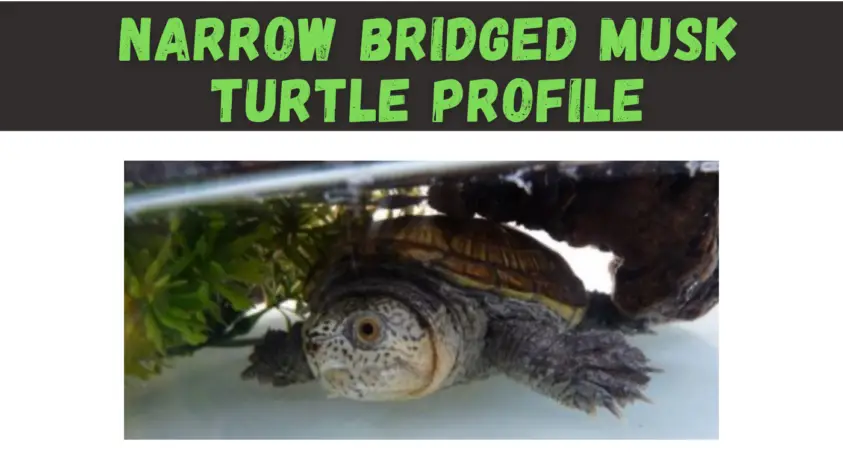The narrow-bridged musk turtle is one of the most fascinating turtle species in the world. Due to it uniqueness and rarity, it is one of the most sought-after pet turtles. In today’s article, I will cover everything you need to know about the narrow bridged musk turtle.
What is the origin of the narrow bridged musk turtle?
The narrow-bridged musk turtle, also known as the Claudius angustatus, is native to regions in Central America. Most narrow-bridged musk turtles live in Mexico.
What kind of temperament does a narrow-bridged musk turtle have?
The narrow-bridged musk turtle is not very friendly. They have an aggressive temperament, and usually don’t like to interact with humans or other animals. This is due to the fact that in the wild they spend most of their time alone in the water hiding in the mud.
What do narrow-bridged musk turtles look like?
One of the reason narrow-bridged musk turtles are so popular is due to their unique color and appearance. They usually have dark brown skin and shell color, and most have a bright yellow or orange mark along the edge of the carapace. Their shell is more domed shaped compared to other aquatic species. The scutes of this turtle range in size, but they are typically larger than other turtles.
Narrow-bridged musk turtles have a very long neck, and their face is narrow (as the name applies). Their face forms into a beak shape, and they have a very strong bottom jaw that typically has a large edge that points upwards.
Where do narrow-bridged musk turtles live?
Narrow-bridged musk turtles are almost completely aquatic and spend most of their lives in the water. They typically live in shallow creeks or ponds where the water doesn’t move very fast. They prefer to live in bodies of water that have a lot of vegetation where they can hide.
What do narrow-bridged musk turtles eat?
Narrow-bridged musk turtles are carnivores, which means they eat both plants and animals. Some common things they eat in the wild include bugs, snails, small fish, and craw fish.
Narrow-bridged musk turtles are excellent swimmers and get most of their food by hunting in the water. They sometimes hide in the mud and wait for their prey to swim by. Due to their webbed feet, they can swim very fast and chase after fish. They have extremely powerful jaws.
How big are narrow-bridged musk turtles?
Narrow-bridged musk turtles usually reach an adult size of around 5 inches. Males are usually have a bigger head compared to females. Males also usually have a larger, thicker tail compared to female narrow-bridged musk turtles.
How much do narrow-bridged musk turtles?
Due to their rarity, narrow-bridged musk turtles are very expensive. In fact, they are one of the most rare pet turtles in the world. Some online vendors sell narrow-bridged musk turtles from $700 to $2,000 depending on availability. Sometimes there are no narrow-bridged musk turtles for sale due to their popularity.
How to take care of a narrow-bridged musk turtle?
For starters, you will most likely need a tank that is at least 75 gallons if you plan on getting a narrow-bridged musk turtle. Since they are such an aquatic species, they will need plenty of space to swim.
They will also need a dry area where they can bask. In order to provided the best basking area, you should make sure you have a UVB light attached to your tank. It is important you have a good light so your turtle can produce both Vitamin D and Vitamin E.
Narrow-bridged musk turtles are a pretty dirty species, and will therefore require a high powered filter to insure the water is clean. Narrow-bridged musk turtles prefer a water temperature between 75-80 degrees fahrenheight.
As for feeding a narrow-bridged musk turtles, I would recommend a combination of leafy vegetables, pellets, and insects. You can also put small minnows in your tank. This will keep your turtle occupied and encourage them to be active as they chase after them.
I also suggest that you add aquatic and land plants to your turtle tank, as this can help replicate the turtle’s natural environment.
It is very important that you do not put your hand inside the tank when you feed your narrow-bridged musk turtle. They have very strong draws that can certainly draw blood. They are also sneakily fast, and can reach out and bite you before you even know what happened. Some narrow-bridged musk turtles can even stick their heads a couple inches out of the water. For this reason, I suggest dropping their food in the water. I would also suggest that you keep a lid on top of your tank so they can’t escape.
Can narrow-bridged musk turtles live with other animals?
While you can definitely put two narrow-bridged musk turtles together in the same tank, I would not suggest putting other species of turtles together with them. They have a very aggressive nature and might attack other turtles.
I also suggest that you do not put pet fish in the same tank as your narrow-bridged musk turtle, as the fish will likely be eaten in a matter of days.
Conclusion
As mentioned earlier, narrow-bridged musk turtles are one of the most unique and sought-after pet turtles in the world. While they are not the friendliest or most beautiful, they are attractive due to their exoticness and strong swimming skills.
If you plan on getting a narrow-bridged musk turtle as a pet, your best bet is to search online turtle vendors. Most main-stream pet stores do not sell narrow-bridged musk turtles since they are so rare.
Even though some people consider narrow-bridged musk turtles as an exotic species, they are legal to own in all 50 states.

